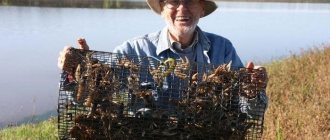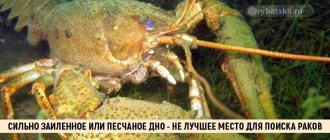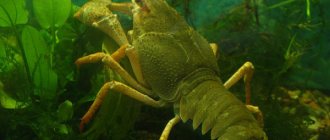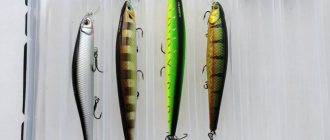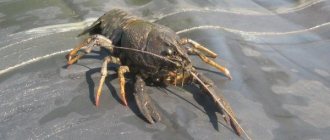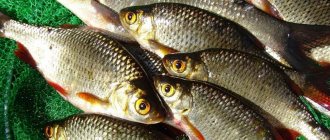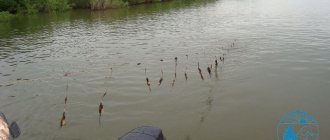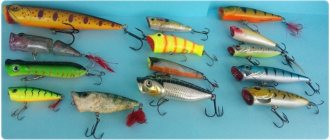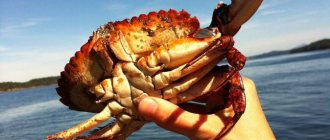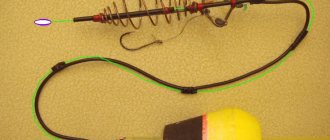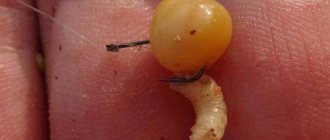It is difficult for fishing enthusiasts to imagine fishing without catching crayfish. This is quite an exciting activity that requires endurance and perseverance. Everyone tried the very tasty and unique meat.
Fishing itself does not require the purchase of expensive devices and other equipment. It will be enough to prepare a crayfish trap and bait for crayfish.
The number of traps per fisherman depends on the fishing area. In each individual area, the limit of traps used is different (usually from 3 to 10 pieces).
In order for the crayfish catch to be successful, and the fishing itself to be only enjoyable, you should listen to some recommendations.
What to use to catch crayfish?
Crayfish is found only in fairly clean water bodies and it will be impossible to catch it in muddy and dirty water. The main habitats are lakes and rivers without strong currents. Prefers reservoirs with a rocky bottom, as it will be easy for him to hide.
Cancer is a carnivorous animal, which is why meat is used as bait when catching it. He is also a scavenger, which means that he himself does not like to hunt, but prefers the bodies of dead inhabitants of bodies of water.
But using rotten meat as bait will not lead to a good catch. To lure him into a trap, it will be enough for him to smell the strong smell of food. To spread the smell, you can cut the bait.
Features of catching crayfish in winter
The end of autumn and the beginning of winter is a wonderful time for catching crayfish. The principle of fishing itself is no different from hunting in the summer. You just need to cut a wide hole to install fishing rods or other fishing devices.
You need to look in clean reservoirs with a rocky bottom. They live at a depth of at least 2-3 meters. In winter, the crayfish hides in deep muddy holes, so you need to take this into account.
To lure it out, you need to prepare aromatic bait, the smell of which will cause the crayfish to crawl out of its hole. Properly prepared bait is half the success. Also, it is very important to find the right place to fish.
What bait should I use to catch crayfish?
It is impossible to accurately name the type of bait due to which the catch will be large. In different bodies of water and at different times, crayfish react to bait differently.
When choosing the type of bait, you need to consider the following:
- The smell of bait. The stronger it is, the more crayfish will crawl towards the trap.
- Its freshness. The bait should not be missing. Cancer will only go for foods with a strong smell if it is hungry. This means that in waters rich in food, this bait will not work.
Crayfish are also caught quite well using various food waste and expired food, but only at a time when they are still hungry.
Time and choice of place for catching crayfish
Taking into account the lifestyle of crustaceans, the most successful time for fishing can be considered the night, when the crayfish feel most safe and come out of their holes in search of food. Crayfish are also active at dawn.
The optimal time for successfully catching crayfish is from 10 pm to 3-30 am.
Crayfish fishing by season:
- January February . Fishing is not very effective, because... crayfish sit in holes, leaving them reluctantly and only occasionally.
- March – May . Crayfish are emerging from their winter torpor, but there is no point in hoping for a large catch.
- May June . Crayfish molt and spawn. Catching them is prohibited in most regions.
- July August . Crustaceans lead a full active lifestyle. You can count on successful fishing.
- September October . In female crayfish, the process of egg formation begins.
- November December . The crayfish practically stop reacting to bait; they have filled up their reserves for the winter, and the females have future offspring under their shells. Fishing is not very effective.
The most productive time for catching crayfish is late summer - early autumn
The dates are approximate, they depend on the climatic conditions of each individual region
Distribution of bait by fishing period
At different times of the year, crayfish react differently to the type of bait:
- Bait for crayfish in spring. Small fish and fish fillets are good bait at this time of year. And you don’t have to catch it yourself; you can buy it in a store. To make crayfish smell the fish faster, the carcasses can be cut before starting fishing.
- Lure for crayfish in summer. In the summer, when there is enough food in reservoirs, animal meat or offal will be a good bait. You can buy them in advance at any store or market.
- Bait for crayfish in autumn and winter. Their catch during this period of time will be good, since the volume of food in reservoirs decreases and bread with garlic can be bait. To prevent the bread from turning sour quickly while fishing, it is recommended to wrap it with garlic in cheesecloth or weave it. It is better not to peel the garlic, but to stuff it into bread with the peel. During this period, many fishermen advise using non-fresh meat and fish.
Tips for catching crayfish with a flashlight
The choice of location directly affects the volume of catch. Unlike daytime fishing, it is recommended to stop on a gently sloping bank where the depth level is minimal. There the water temperature will be as high as possible in the entire reservoir. The best option is that a sharp change in the bottom topography begins 10-15 meters from the shore.
How to choose a good tent for winter fishing: TOP 3 popular models
To effectively catch crayfish you will need the following:
- Flashlight. It is advisable that it have a water-resistant case, as there is a high probability of dropping it into water. You will also need a securing cord to secure it to your hand in case the flashlight falls.
- Net or gloves. They are necessary to protect hands from possible damage from claws. The first requires practice, since when there is danger, the crayfish can develop high speed - in one swing of the tail it moves 20 cm.
- Boots or other waterproof footwear. Water temperatures may be low during the fishing season. To prevent chills or illness, foot protection is recommended.
Cloudy weather increases the chances of large numbers of prey. But it can also cause poor visibility. Read about how atmospheric pressure affects fishing here.
Features of baits when catching crayfish using crayfish traps
To get a good catch of crayfish, the type of bait is of great importance. Cancer must be lured into a trap; he will not go into it himself.
Commonly used and effective baits are:
- fish (preferably fresh);
- cake;
- garlic;
- mollusks living in the reservoir where fishing will take place.
Fish is most often used as bait; it must be elastic. There will be a good catch if the bait is roach, bream or perch.
Of course, these are not all types of bait.
Experienced fishermen also use their own time-tested baits, but in any case, they must be fresh.
In order for the crayfish to crawl into the crayfish trap faster, a strong smell must come from the bait.
For example, to enhance the smell of fish, it is better to make a cut along the vertebra and turn the meat out.
It will be enough to put one fish in one trap overnight.
The second most popular bait is occupied by mollusks (mussels and clams). The bait may be live. You can find a snail or shell in a pond and put it in a trap.
Bait for catching crayfish
Despite the general belief that crayfish should be caught using rotten meat, this is not the case. The strong smell emanating from the bait is necessary only in winter, when the smell is less transmitted in water. In summer you can also fish with fresh meat or fish. It is best to use for bait the living creatures that live in the reservoir where the crayfish are.
The fish is cut lengthwise and turned inside out, so the smell will spread more strongly. You can also add strong-smelling vegetables, such as dill, along with the main bait. Ordinary black bread rubbed with garlic is widely used as bait. Dry cat food with fish flavorings is also often used.
DIY bait
You can easily make your own bait for catching crayfish.
Here are some fairly simple tips:
- Grind a loaf of black bread and a small head of garlic in a meat grinder. Roll small balls from the resulting mixture and place them in gauze or fabric bags. When fishing, put these balls in a crayfish trap.
- You can only grate pieces of bread with garlic without grinding them in a meat grinder.
- Cake is considered a good addition to bait. It is added to the bread and twisted, or small pieces of cake are pushed into the bread and placed in fabric bags.
- Crayfish lovers use canned fish for bait. Several holes are made in the jar on both sides, and it is placed in a trap.
- Freshly caught fish will also work. But first you need to wither it a little in the sun, and then place it in a trap.
How to catch crayfish using a crayfish trap?
Open type shell
Using such traps is the easiest and cheapest way to catch crayfish.
Such traps consist of a wire circle with a diameter of about 70 cm (the wire can be replaced with a wooden circle), onto which a del is placed so that it sags a little in the middle.
If the trap will be used at depth, then four ropes are tied to it, which are then tied in a knot, with a long end coming from it for raising or lowering with a homemade float.
If the fishing for crayfish is in the coastal zone, then the role of the catch of the trap will be played by a long pole.
It is securely fixed in the ground. The contents of the crayfish traps should be checked every 15-20 minutes.
Closed shell
Its use will give the best results. The advantage is that it does not need to be checked frequently (usually 2-3 times in one night). Their disadvantage is volume.
They are used to catch crayfish in one body of water, and to prevent them from floating, a weight is placed on its bottom. They are convenient because once a cancer gets into such a trap, it will not be able to crawl back out.
Basic methods of catching crayfish
There are several main ways of catching crayfish: catching with your hands, fishing with a spear, catching crayfish with an open and closed crayfish. Let's take a closer look at each of them.
Read! Pike habitats
Catching crayfish by hand
The easiest way is to catch crayfish with your hands. With this method, the catcher enters the water just above the knee and slowly walks through the water looking for his prey. During the daytime, the crayfish sits under driftwood and stones. By lifting them, you can catch a sufficient number of arthropods.
You should know that crayfish move quite quickly under water, and they do so with their tail first. Therefore, you should pull it out of the water very quickly. This method is suitable for those who are not afraid of its claws.
Catching crayfish with a spear
In order not to fall into the tenacious grip of the crayfish, you can take with you an ordinary stick, split at the end (split); it cannot pull the prey out of the water, but it can be pressed to the bottom. After this, you need to take the crayfish by the shell, closer to the tail, while it will not be able to reach your hand with its claws.
What time to catch crayfish with crayfish?
Crayfish are caught in different ways throughout the year.
In order for the catch to be large, you should take into account the peculiarities of fishing for them:
- January and February - the crayfish sits in its holes at this time and is not caught;
- March, April - begins to awaken from hibernation and come out of holes, but is caught very poorly;
- May - this month the crayfish molts, and it begins to lay eggs, which is also difficult to catch;
- June - fishing is weak, since molting is still ongoing;
- from July to October is the best period for fishing; the crayfish has become active after molting, eating well and gaining weight;
- November and December - at this time the largest ones by weight are caught, and the females will have caviar under their shell.
The catch of crayfish according to these dates cannot be called accurate; everything will depend on the region and climatic conditions in it.
How to catch drag fish
The general principle of this type of fishing is simple. Two fishermen pull a drag along accessible places. Then they either turn towards the shore or gradually converge. All this time, beaters walk next to them and on their sides at a short distance. When the barge haulers converge, the beaters close the circle, slap the water, and drive the fish into the trap.
Then the bottom of the network gradually rises. Here you need to keep an eye on the top cord. It should not be close to water. Fish driven into a tight circle can jump out over the top. When choosing a net, lift the neck of the fish and select the fish. If you do not violate simple rules, the size of your catch will please you.
Choosing a fishing spot
When fishing on small rivers, the choice of length depends on the width of the river. Good places are river pools and shallow water with riffles. If there are few fishing spots on a small river and the path to them is at a great distance, artificial creeks and pits can be installed on the river. Select a place with a flat bottom surface. A small dam is made that does not block the river, but greatly narrows the passage of water.
It is made from any available materials. The water level is rising. In this place, fish remain after spawning, as well as “local” fish. You just need to catch fish in a businesslike manner, without barbarism, while simultaneously creating comfortable conditions for growth and development. Trees can be dropped here and bait can be added. And then this place will bring a stable catch.
On large and medium-sized rivers, the length of the drag increases. Good places here are bays, channels among reeds and sedges. Weak currents in floodplain areas attract fish. The fishing technology here is different. A short haul will bring only small change in the catch. To catch large fish, you should use longer gear.
On large lakes and rivers, fishing with this method directly depends on the length of the drag. It is better to fish in shallow places, but only before spawning and at other times when fish gather in schools.
Ponds, if they are small and have a clean bottom, can be fished without going into the water. Here you should look for places with streams flowing here, holes and edges between them.
Fishing technique
It can be very difficult to freely approach a place on a reservoir where crayfish are found due to the fact that their shoreline is overgrown with reeds. Experienced fishermen advise placing crayfish traps from boats.
In order not to spend a long time looking for traps along the entire bottom of the reservoir, but to be able to easily find and lift them, a homemade foam float is tied to the top of the cord. It will indicate the location of the trap.
You can also set the trap from the shore, following a certain sequence:
- find a stick with a slingshot at its end;
- take the cord from the trap in one hand and the stick in the other;
- lift the trap by picking up its cord;
- slowly lower it into the water;
- Tie the cord from the trap to a tree or stick.
Lifting it out of the water by the cord, the catch is taken out, and the empty shell is lowered back into the water.
By applying all these tips, you can be sure that fishing for crayfish will bring only positive emotions and a sense of satisfaction.
carpcarp.ru
Catching crayfish on a ranch
Recently, the ranch has been in quite high demand. In essence, a rachevnya is a kind of basket knitted from nylon thread. By the way, a metal mesh will also work. Hoops for such a simple design are made from galvanically coated wire. Before the wire, natural material was used (willow and bird cherry twigs), and in the center of such a basket for pulling, a stone, an iron object or a bag filled with sand was suspended.
The standard size of the hoop is 50 cm. By evenly distributing 3-4 loose cords of the same size over the hoop, they are securely fixed to avoid a strong tilt of the basket, and then tied together. The loop of such a knot serves as a fastening for a more powerful cord, due to which the rack is lowered and raised.
To fish from the shore, you need to secure the cord to a pole. The bait can be fixed either on a tension cord along the diameter of the hoop, or on a thin branch, which is also attached to the hoop. So, the device is ready for use and can be lowered to the fishing point. To make it easier to remove the rope from the water, the cord is attached to a buoy or to a pole, which is stuck into the edge of the shore. The principle of such a trap is quite simple: the crayfish clings to the bait, and when the basket is lifted from the water, it has no opportunity to get out of there. When lifting the rack, you shouldn’t fuss, but pull it out quickly and confidently. Just like fishing rods, fishing rods can be placed at a distance of 5–10 m from each other.
Choosing a crayfish trap
There are several types of clamshells. The simplest models consist of two hoops covered with mesh.
A rope is attached to such devices, which is used to lift the crayfish out of the water. Hoops do not have to be round. You can use square or oval models with the same success. Open type shells have a significant drawback.
Crayfish can easily leave such a trap after eating the bait , so open crayfish traps require constant supervision, and traps must be checked several times within an hour.
A more complicated shell design is made of several hoops or squares with a fine mesh stretched between them. In this case, the inlet hole should be relatively small. Cancer, after it gets into such a trap, cannot always leave it on its own, even after the bait is completely eaten.
The shells can be cylindrical in shape. Inside such a shell, in the middle, there are small holes for entry.
Such traps are most often made of hard plastic. The entire design of such a crayfish trap has small holes that allow the aroma of the bait to spread freely throughout the reservoir and prevent the crayfish from leaving the trap.
The cost of crayfish traps usually does not exceed several hundred rubles and depends on the dimensions of the product, material, and type of trap.
Cancer, after climbing into such a trap, cannot always leave it on its own, even after the bait is completely eaten
Catching crayfish with a fishing rod
With this method of fishing, you can use almost any bait: corn, dung worm, etc. But the favorite food of arthropods is still crucian carp and roach; it is desirable that the fish be slightly rotten. Before you go hunting for crayfish, it is recommended to catch a small fish and dry it a little in the sun. Then you should put such bait on the hook. It is not so important in what position it will be located: along or across. By the way, there is an option without using a hook at all: the fish is wrapped in fishing line and thrown into the water. Cancer grabs her with its claws and begins to pull her towards him. At this moment, you can begin to carefully pull it out of the water, but you should not make any sudden movements.
By the way, instead of a fishing rod and fishing line, an ordinary stick with a cord or strong rope will do. For greater catchability, you should not give up using a hook, but, on the contrary, fix a large tee on the fishing line - the result is guaranteed. How does a float on a fishing rod behave when catching crayfish? The bites of arthropods are distinguished by their slowness and at the same time complete confidence. Having caught the bait, the crayfish begins to drag it and, consequently, the float also slowly moves to the side, then sinks and gradually sinks into the water.
To prevent the crab from getting off the hook, you do not need to loosen the tension of the fishing line, otherwise the prey will simply leave. At the same time, you can place dozens of fishing rods and sticks at a distance of 5–10 m from each other, and 2.5 m from the edge of the shore. Of course, you need to take into account the density of arthropod habitat in a given reservoir. It is advisable to check fishing rods and sticks several times within an hour. It is advisable that the fishing area does not exceed 100–200 m in length, otherwise there will not be enough time to inspect the fishing rods, and the crayfish will have time to eat all the bait. If the catch decreases, you should move to another point.
Catching crayfish with a fishing rod (angling) is considered one of the most effective methods. An indicator of an arthropod attack on the bait is the corresponding swaying of the end of the stick to which the fishing line or rope is attached. It happens that up to 12 individuals are pulled out at a time.
Lures
If a small fish is used to catch crayfish, then the air bubble is pierced, otherwise the bait will float up in the crayfish trap and catching crayfish will not be effective.
Various natural products are used as bait for catching arthropods. Crayfish is omnivorous, so bread grated with garlic and fresh fish can be placed in the crayfish trap. The claim that crayfish are attracted to the smell of rotten meat is untrue.
Of course, when arthropods experience a nutritional deficiency, they attack any food, even with a strong odor. If cancer has a choice, it eats fresh fish.
When fishing is combined with catching crayfish, the best bait is fish caught with a fishing rod, which is kept in the sun for 2 - 3 hours. If you manage to catch a large fish, then you can use a fish head to catch crayfish.
If a small fish is used to catch crayfish, then the air bubble is pierced, otherwise the bait will float up in the crayfish trap and catching crayfish will not be effective. An excellent bait for catching crayfish are mollusks that are found in a body of water where arthropods live.
The shell of the mollusk should be opened with a sharp knife and in this form placed in shells. There is no need to additionally weight this bait; the shell has significant weight, which will not allow the bait to float up. To catch crayfish, you can use frozen fish, which you buy in a store: it is thawed and used. Frozen products are not inferior in effectiveness to fresh, just caught fish.
Adding dill to plant baits significantly increases the catch of crayfish; you can use artificial attractants with odors that crayfish like, such as fish and shrimp.
How to catch
Good results in catching arthropods can be obtained on a cloudy day; at this time, the behavior of the crayfish does not differ from night outings in search of food.
Catching crayfish with a closed and open crayfish trap differs slightly. An open trap requires more frequent checking of the gear; a closed trap can be left overnight or for a longer time. Cancer will not be able to get out of a closed structure on its own.
To install both types of crayfish traps, select a place with a steep bank. It is advisable that there be some hiding places for the crayfish underwater. You can count on a large catch of crayfish where there are large stones at the bottom of the reservoir, under which the crayfish make their burrows.
Reservoirs with low oxygen content, dirty water, and a sandy bottom are practically unsuitable for catching crayfish. The depth of the reservoir does not matter when catching crayfish. If there are all conditions for the life of crayfish at the bottom, then they can be found both in deep-sea places and at a depth of no more than 0.5 meters.
At night you can catch crayfish with greater success than during the day. You can leave closed traps overnight and check the gear in the morning. Good results in catching arthropods can be obtained on a cloudy day. At this time, the behavior of the crayfish does not differ from night trips in search of food.
An excellent place for catching crayfish can be areas of reservoirs where water is pumped from one reservoir to another. During the operation of the pumping system of such water pumps, small fish are injured and there is always a large amount of food for crayfish in such places.
To fish near water pumps, it is not necessary to stock up on bait ; you can use a fine-mesh net to catch a fish floating belly up, cut it, and secure it in a trap to catch large numbers of arthropods.
How to catch crayfish in winter
There are different ways to catch crayfish from a hole in winter. To choose a worker, you need to delve into each of them.
Winter crayfish and fishing with them
Catching crayfish with crayfish from ice is considered the most effective way. They are distinguished by their versatility and ease of use. The main thing is to make a hole of the appropriate diameter. You can catch baleen with both open and closed type crayfish traps.
The first type is a simple design that can easily be assembled with your own hands from available materials. It is enough to put an iron mesh on a metal or wooden circle to get something like a ditch lag. To deliver and remove the winter crayfish, use a strong rope fixed to a ring. The length of the cord is selected depending on the working depth.
Closed type traps are characterized by increased reliability and efficiency. Cancers cannot get out of them on their own; they have no chance of getting out. Externally, the shell is similar to a cylinder with several stiffening ribs.
The principle of catching crayfish in winter using a crayfish trap:
- Prepare bait in the form of fish, bread and garlic. It is worth using different bait options in several traps.
- Lower the shell to the bottom.
- Tie a rope from it to a peg installed next to the hole.
- Mask the hole and protect it from freezing with straw and branches.
- Check the hole after an hour. If the trap is an open type, then the number of checks should be increased. If there is a catch, it needs to be removed and bait added.
- Place the shell back into the water.
Scraper
With the right approach, achieving a rich catch using a drag net is not so difficult. Using this trap is equally effective both on a reservoir with calm water and with a current. Use the trap before the freeze-up begins, 50 m from the shore.
This rectangular structure, made of metal wire with a diameter of 1 cm, looks like a bag woven from mesh. A strong cord or rope is attached to the top.
The algorithm for catching arthropods is as follows:
- Cut fish, beef udder, and any suitable bait into small pieces.
- Load pieces of bait into the trap.
- Cast into the water.
- Drag by the rope to the shore.
- Seize the catch on the shore.
Winter fishing rod
It is often possible to catch crustaceans using float gear. For many, this method is more interesting than others. Catching crayfish in winter with a fishing rod requires active action and dynamic movement.
In general, the rod for the mustachioed inhabitants of the reservoir is the same as for catching fish. Just instead of the usual single hook, use a tee, from which the crab cannot get off. You can catch prey without a hook; just wrap the meat with fishing line and throw it to the fishing point. The mustachioed fish will grab the bait with its claws and begin to pull it to the depths. The hunter needs to react in time, make a confident hook and bring the catch out of the water.
Rachevnya
This cylindrical mesh device is made from a metal hoop and a thin rope tied to it. The diameter of the hoop is half a meter. Previously, it was made from willow twigs, but in the modern version it is durable wire with a special coating.
The trap is lowered and raised using cords that are connected to each other by a knot. There is a weight in the center of the trap; the bait is fixed to a net stretched over a hoop. A good catch is also obtained when using an improved design, where there is an additional metal hoop. The bottom of the trap is connected to the upper hoop using a woven mesh.
Hand catching
Winter fishing with crayfish, crayfish and dragnets is always effective if properly prepared. But you can catch mustachios with your hands, but it’s better to do it at night. During the cold season, this method is quite extreme, and is not suitable for everyone. It is optimal to use crayfish traps and crayfish when the reservoir is covered with ice.
To find crayfish, arm yourself with a flashlight. They light the way along the coastline. When an arthropod appears on the horizon, it is picked up either by hand or with a net. You should enter from the tail section without removing the flashlight. This technology is relevant until the freeze-up begins.
Blitz tips
- Crayfish have a highly developed sense of smell, so all baits used in catching crayfish must emit a smell. The garlic smell is especially attractive to arthropods. You can check the effectiveness of such aromatization by rubbing a piece of brick with garlic and placing such bait in a trap. After a short time, arthropods will definitely “enter” the crayfish trap, attracted by the pleasant aroma. If the smell is not strong enough, especially for vegetable baits, then they must be additionally flavored with garlic juice.
- In all cases, except for the use of shellfish, the bait must be securely attached to the bottom of the crayfish trap. For this purpose, a pocket made of nylon fabric is sewn at the bottom of the trap. It is possible to attach a large bait with an elastic band, and if the structure is quite dense, then you can use a pin for this purpose.
- The most favorable time for catching crayfish is from July to December. At this time, the crayfish gains significant weight, and caviar deposits begin to form in females. Almost any bait of animal origin can be used as bait at this time. You can use white bread rubbed with garlic and wrapped in cheesecloth.
- When using fresh fish as bait for catching crayfish, it must be cut along the body. This must be done to attract arthropods with the smell of fish meat and blood.
- Ponds near poultry farms may be promising places for catching arthropods. Meat production waste often ends up in such reservoirs, and there can be a huge number of crayfish in such places.
lakeking.ru
How to catch crayfish in the warm season?
As everyone knows, crayfish can only be found in reservoirs with clean waters; they live in burrows, under stones and flooded snags. They feed mainly on underwater vegetation - water lilies, algae, elodea, as well as food of animal origin - worms, fish, and other crustaceans.
In winter, crayfish do not change their place of residence, but simply go further into the depths, where the water does not freeze and the temperature is more or less stable.
Winter is the hottest time for catching crayfish.
From November until the onset of spring, crayfish lead an inactive lifestyle, staying in their houses for almost 20 hours a day. By the way, female crayfish, unlike male crayfish, continue to lead a normal lifestyle even in winter, since at this time they carry eggs under their tail - offspring.
The most popular baits for crayfish fishermen are small fish, river mussels or frogs. The first option is the most popular.
Crayfish eat roach, bream, and silver bream with pleasure. You should not use perch or pike to catch crayfish.
One more point: the bait must be fresh. The aroma of the fish will be stronger if the carcass is cut along the back to the vertebra.
You can also use the meat of the crayfish itself as bait - large claws and the neck.
In summer and early autumn, crayfish are caught in many ways. Many fishermen pull them out of holes with their hands, but this is risky, because a hand can get stuck in a hole, or the crayfish can clamp its claws on a hand. Rakolovki or rachevni are the most popular and easiest way of fishing. After all, you can catch several individuals in one go. And the process itself is very simple and does not require complex steps.
Catching crayfish in winter is practically no different from fishing in the warm season. The same gear and the same baits are used. You just need to take more aromatic pieces to lure out the crayfish, because in cold water the smell will spread more slowly and its saturation will decrease. The process of catching crayfish is quite interesting and can bring a lot of positive emotions and good catch to the fisherman.
Fishing with hands and spear
Since the crayfish fishing season occurs mainly in the warm season, the easiest way is to catch with your hands. The answer to the question of how to catch crayfish with your hands is quite simple, but the specifics depend on the time of day. During the day, they simply search all the interesting areas of the bottom - under snags, between stones, various holes found at the bottom. Especially carefully it is worth examining the steep banks that go steeply into the water. It is convenient to fish not alone, but with a partner - while one lifts stones, the other catches the discovered crayfish. But it is believed that daylight hours are not the best choice, since crayfish are more active at night. To increase efficiency, you can use a breathing tube, a mask, or a flashlight that works underwater.
Night, according to many anglers, is the best time to catch crayfish. At night, they go to the shallows in search of food, where it is especially convenient to catch using artificial lighting. At the same time, many fishermen recommend lighting a fire on the shore, since the light does not scare away, but, on the contrary, attracts crayfish.
Among the simplest devices that can be made right on the spot, it is worth highlighting the spear. This is a long stick with a wedge inserted into the split, due to which its ends diverge to the sides. It is better to use raw wood (ideally, the stick should be just cut) rather than dry - in this case it retains its elasticity and does not break when fishing. The spear is used in the following way - having noticed a crayfish, they press it to the bottom with the forked end of the spear (the shell of the crayfish is strong, such fishing usually does not cause serious damage to the catch), after which it is not difficult to pull the prey out of the water.
fishelovka.com
Almost every one of us has ever tried to catch crayfish. Someone in childhood, diving for them with a mask, someone accidentally caught crayfish while fishing. Some people use fishing devices in this matter. And there are people who catch crayfish professionally, having the necessary equipment.
So, in this article you will learn about the characteristics of life, behavior and methods of catching these arthropod creatures.
Crayfish are an indispensable orderly for water bodies. Crayfish help the pond get rid of fallen fish, dead small animals and other carrion. Many people believe that the main diet of crayfish is carrion, and the more it has decomposed, the more they are attracted to it. However, this is not true, because the diet of crayfish consists of 90% plant foods. These are mainly algae that grow at the bottom of the reservoir. In addition, leaves from trees, acorns, soggy roots hanging from steep banks, and so on.
Of the animal foods, the main delicacy of crayfish is sleeping white fish: roach, bream or bream, and redfish. As a rule, crayfish are very reluctant to eat the flesh of predatory fish. Some fishermen attribute this to the fact that in life these underwater inhabitants are enemies. Some suggest that the meat of predatory fish has a specific taste. There are other opinions. You can test this theory yourself. To do this, you need to take four small circles covered with mesh. Place white fish bait in two of them, and giblets and perch heads in the other two. After a few hours you can check. Most likely, the result will be in favor of white fish (with a ratio of 1 to 10). In addition, crayfish willingly eat the meat of various animals. At the same time, pork and beef are significantly superior to poultry meat.
Many people associate cancer with a carrion eater. It is for this reason that the vast majority of novice crayfish hunters use rotten fish meat or animal meat with a strong odor as bait. And then they wonder why they catch so few crayfish or not at all with such a smelly bait. It's a common misconception that cancer likes bad smells. On the contrary, crayfish only like fresh meat. After the bait in the form of a piece of meat has been in the water for more than 3 days, the crayfish lose all interest in it.
Catching crayfish using crayfish traps is one of the most common methods. You can fish with crayfish at different times of the year, in spring, summer, autumn, and even winter. The best months are May, June, July, September, October.
There is nothing difficult in this method of fishing (this is not fishing), you only need crayfish, bait, and a suitable body of water in which these arthropods live. More details can be found in the following video.
Possible baits for catching crayfish using crayfish traps and other tackle:
1. In first place, undoubtedly, comes the carcass of white fish. It is advisable that the fish be from the same reservoir. To use a fish as bait, it must either be cut into pieces (if it is a fairly large specimen) or its belly must be pierced in several places. This is done so that the odors that crayfish like come out of the fish more strongly.
2. Meat from large livestock. In first place are the tubular bones with a small amount of meat remaining on them. On the second there are small pieces of meat. But crayfish may simply not have time to eat such bait, because other inhabitants of the reservoir are also not averse to eating it. Crayfish do not really like poultry meat and bones.
3. Large river shell. This is also a delicacy for crayfish. But, firstly, the shell is the orderly of the reservoir along with the cancer, therefore it is not entirely humane to deprive the reservoir of two of its important inhabitants in one process. Secondly, shell meat is also a delicacy for fish, for this reason crayfish do not always have time to get it.
4. Plant bait. A classic bait for the cold season is bread with garlic. The recipe for making this bait is quite simple. You need to take a loaf of black bread and a large head of garlic. All this is ground in a meat grinder, then small balls (3-5 centimeters in diameter) are formed. Garlic does not need to be peeled. Some inexperienced crayfish hunters are afraid to add too much garlic. From my own observations, it is worth noting that garlic cannot be superfluous. The more of it in the bait, the better. The main types of food and bait for crayfish were discussed above. Now it’s worth describing the places where they live.
Crayfish do not like great depths, strong currents and flat bottoms. First of all, you should look for crayfish in steep or rocky areas of the reservoir. There are quite steep and deep cliffs, especially in those reservoirs that are artificially created by man. When fishing such places, it can be noted that crayfish are found in the burrows of this cliff to a depth of plus or minus 5 meters. There are no crayfish or holes below. Crayfish are found quite often in rocks, but fishing in such places is not safe due to the possibility of injuring your hands on the sharp edges of the rocks. And crayfish have such winding passages between the stones that it is almost impossible to catch them.
Often crayfish are found among algae, but it must certainly be large algae with moderate thickets. Cancer prefers to live among water lilies, which allow him to hide from his enemies. On flat terrain, in sandy and silty areas, crayfish are found only in search of food.
This method of catching crayfish with a flashlight also exists, so we will also recall it in this article. But you need to know that catching crayfish at night using lighting is prohibited.
In the daytime (during the day), crayfish are caught by hand in burrows. Suitable places for this will be steep banks. Or areas of a reservoir where trees grow close to the water, in the roots of which crayfish also hide. For catching crayfish with various devices, undoubtedly, the best time of day is night, or rather the period from sunset to dawn. Cancer is nocturnal; during the day it stays hidden and is inactive. This is due to the fact that the cancer digests the food it obtained at night. He tries not to catch the eye of the fish, since he himself can become food. Cancer is active at night. Some individuals can move up to 300 meters during the night in search of food. Often at night, crayfish run aground up to ten centimeters deep.
As for the time of year, the best period is from May to October. That is, catching crayfish in spring, summer, and autumn will be more successful than in winter. In May, after the females free themselves from the small crustaceans, the adults begin to actively feed. Zhor continues until the end of July. Starting in October, the water in reservoirs begins to cool, and crayfish become less active.
From this moment until the freeze-up, crayfish must be caught using baits with stronger odors than in summer. In cold water, odors spread more slowly, and weakly active crayfish need to be interested in something more interesting. In winter, after ice forms on reservoirs, crayfish also continue to feed if they come across food. At the same time, they do not make long forays in winter in search of food, but only eat what falls “under their nose.” From February to the end of April, crayfish cannot be caught; they are in their breeding season.
It is also worth noting that crayfish live only in clean and oxygen-rich water, without harmful industrial impurities and sewage. They may well be an indicator of the cleanliness of the reservoir. It happens that a year ago there was an abundance of crayfish in the reservoir, but this season there are none at all or only a very small amount remains. A sharp decrease in the population of crayfish in a reservoir is a clear sign of moderate or severe water pollution. Most likely, in this reservoir the crayfish will disappear altogether.
Catching crayfish has its limitations, that is, there is a ban established by the State Fisheries Agency. To find out exactly which months it is prohibited to catch them, look at the spring-summer spawning ban for 2021 in Ukraine. Where for each region the permitted and prohibited areas for fishing are indicated, including for catching crayfish. It was also mentioned above that catching crayfish at night using illumination (flashlight, torch, etc.) is prohibited.
The fine for violation during the prohibited time of year and method of fishing ranges from 34 to 680 UAH. In addition, for each crayfish you catch you will have to pay 25.50 UAH. In Russia and Belarus, the fines are different, and if you know them, please let us know in the comments.
At other times, the norm for catching crayfish per day per person is up to 30 pieces.
lovlia-na-dnistri.ru
Catching crayfish with a spear and a shoe.
Can be used for catching crayfish. To do this, in a place where the water is especially clear, near the shore you need to throw some kind of meat, fish entrails, etc. bait. A spear for catching crayfish is a long stick split at one end. A wedge is inserted into the split so that the edges of the stick diverge by several centimeters. Moreover, you need to take a fresh, damp stick, since a dry one has little elasticity and can easily break.
The spear is carefully brought to the crayfish and stuck into the bottom. The crayfish falls between the forks and is pinched at the top of the split, after which all that remains is to pull it out of the water. As a last resort, you can catch crayfish with a shoe. To do this, shoes with bait lowered inside on a long rope are immersed in the bottom of the reservoir. Having climbed inside, the smell of the crayfish is lifted ashore.
Based on materials from the book Great Encyclopedia of Survival in Extreme Situations. Andrey Ilyichev.
What bodies of water do they live in?
Today there is a very common misconception that crayfish are unpretentious to the environment and can live in virtually any body of water. In fact, this is not so and these arthropods are only grown in places that meet the following requirements:
- The water must be exclusively fresh, since even in a salty-fresh environment conditions are created that are unsuitable for full development.
- A sufficient indicator of oxygen concentration; in warm weather it should be at least 5 mg/l. For this reason, crayfish often coexist in reservoirs with various salmon fish species, which impose the same conditions on the environment.
- Moderate level of acidity, pH should be at least 6.5.
- A sufficient amount of lime, without which natural growth is impossible.
- Bottom surface with a solid structure and minimal silt content. For this reason, it is useless to try to search for and catch such prey in places with muddy, sandy or rocky bottoms, since they are not suitable for creating burrow-like dwellings.
Crayfish fishing area
Crayfish are very picky in their choice of habitat, so they do not live in every body of water. What should be the conditions:
- Pure water. This is the main condition for the life of these arthropods. Only this concept does not mean the case when the bottom of a reservoir can be seen through several meters of water, but the absence of various chemicals and harmful impurities is important.
- High oxygen content in water.
- The bottom of the reservoir should be rocky (with many holes and shelters where the crayfish will hide) or soft clay (so that the crayfish can dig holes for themselves).
By their nature, Cancers are loners. Each individual lives in its own separate burrow. The length of the hole can reach one meter in length. You can often find crayfish:
- in plant roots;
- under snags;
- in dense aquatic vegetation.
In search of food, the crayfish comes out after darkness or cloudy weather.
When to catch crayfish
The current time of year has the greatest influence on catching crayfish; in accordance with this criterion, the following periods can be distinguished:
- In January or February, all arthropods hide most of the time in muddy holes and try not to get out, so fishing is unproductive.
- From March to April, a gradual awakening begins; you can start setting up fishing devices, but the catch will not be significant.
- From May to the end of June, you can’t count on a good catch, since arthropods are busy shedding their old shells and laying eggs.
- In July, a long period begins, which lasts until December, during which crayfish fishing is very effective. This is due to an increase in the activity of prey, which begins to look for food and explore the reservoir.
- September and October are periods for weight gain as the females begin to develop egg deposits. By mid-November or early December, crayfish gain significant mass.
How to increase your fish catch?
Over 7 years of active fishing, I have found dozens of ways to improve the bite. Here are the most effective ones:
- Bite activator . This pheromone additive attracts fish most strongly in cold and warm water. Discussion of the bite activator “Fish Hungry”.
- Increased gear sensitivity. Read the appropriate manuals for your specific type of gear.
- Pheromone -based lures .
Restrictions and bans on fishing
It is important to know that during certain periods there are bans on catching crayfish; their terms vary individually in all areas and regions.
We strongly recommend not to break the law and follow its instructions.
It is necessary to clarify such information in advance, since penalties are imposed for violating current restrictions. Below are the prohibitions only for some areas that are the most popular for catching crayfish:
- On the territory of Moscow, the entire Moscow region , as well as the Republic of Mordovia, there is a permanent ban on fishing at any time.
- In the Astrakhan region, the ban starts in April and ends only in July. The size of the caught prey should be 10 cm or more.
- In the Smolensk and Tambov regions, the ban starts in October and is lifted only in July; the rest of the time, the size of production must exceed 10 cm.
- On the territory of the Stavropol Territory, the ban begins to apply with the onset of winter and is lifted only on August 15; during the time allowed for fishing, the size of the prey must be equal to or exceed 9 cm.
- In St. Petersburg and the entire Leningrad region there are no clear dates for the ban to begin, but restrictions are lifted only on July 15. During the period permitted for fishing, the size of the prey should not be less than 9 cm, while the wide-toed variety is prohibited from being caught throughout the year. The same restrictions were introduced in the Pskov region.
- On the territory of the Rostov and Orenburg regions, each reservoir has individual start and end dates for prohibitions, so you must first find out about them when going fishing to a certain place.
- On the territory of the Republic of Adygea, the ban begins to operate on January 1 and is lifted only in mid-June. In the Republic of Kalmykia, the validity period of the introduced restrictions has been extended by two weeks, and fishing is resumed only in July, and the size of the catch must be at least 9 cm.
- In the Novgorod region, the ban begins to take effect on May 25, but its duration is 17 days. It should be borne in mind that catching the broad-toed species is prohibited throughout the entire season.
- In the Kursk, Bryansk and Vladimir regions, the ban is valid from the first days of October to the beginning of July; the rest of the time, the size of the prey must be at least 10 cm.
- On the territory of the Krasnodar Territory, the ban is valid from the first days of January until the end of May, but for water bodies that are part of the Azov Sea basin and have fishery importance, it has been extended until June 14.
- In the Kaliningrad and Kirov regions, the ban is valid from early October to early July. The exception is the Yug River and all its tributaries; on these reservoirs located in the Kirov region, arthropod fishing is prohibited from June 15 to early August.
- On the territory of the Volgograd region, the ban begins to operate in early January and lasts until September 14, but on the Tsimlyansk reservoir it is extended.
Ban on catching crayfish
Prohibitions on catching crayfish in the regions are established by the Fishing Rules for each fishing basin!
- Astrakhan region - a ban on catching crayfish is established from April 1 to June 30. At the time when crayfish can be caught, their size must be at least 10 cm.
- Bryansk region - the ban on catching crayfish is valid from October 1 to June 30.
- The Vladimir region has established a ban on catching crayfish from October 1 to June 30.
- Volgograd region - the ban on catching crayfish is established from January 1 to September 14, and in the Tsimlyansk Reservoir the ban on catching freshwater crayfish is valid from January 1 to September 15.
- The Vologda region prohibits catching crayfish during the period of gestation, as well as during molting and from June 15 to July 31. During the period when crayfish can be caught, their size must be at least 9 cm.
- Kaliningrad region - the ban on catching crayfish is valid from October 1 to June 30.
- The Kirov region has established a ban on catching crayfish from October 1 to June 30, and in the Yug River with its tributaries it is prohibited to catch crayfish from June 15 to July 31.
- Ban on catching crayfish in the Krasnodar Territory: For the Black Sea and the basins of rivers flowing into it, the ban on catching crayfish is valid from January 1 to May 31.
- For water bodies of fishery importance in the Azov Sea basin: from January 1 to June 14.
- from June 5 to July 15 - crayfish in water bodies of fishery importance in the Svetlinsky and Yasensky districts; from June 15 to August 10 - crayfish in other water bodies of fishery importance in the region.
- from January 1 to June 10 - freshwater crayfish in water bodies of the Manych River basin;
